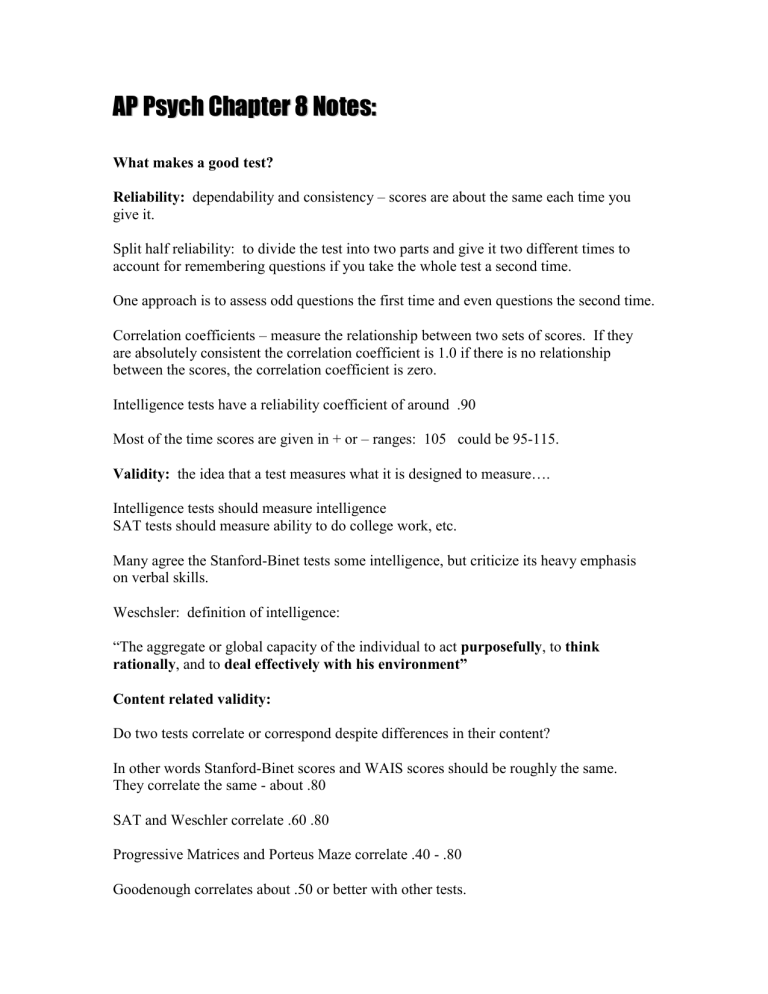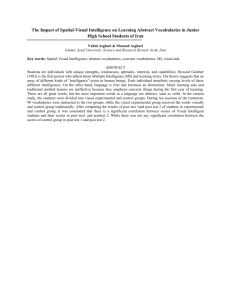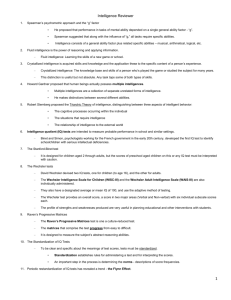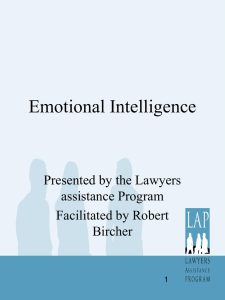Chapter_08_Notes

A P P s y c h C h a p t t e r r 8 N o t t e s : :
What makes a good test?
Reliability: dependability and consistency – scores are about the same each time you give it.
Split half reliability: to divide the test into two parts and give it two different times to account for remembering questions if you take the whole test a second time.
One approach is to assess odd questions the first time and even questions the second time.
Correlation coefficients – measure the relationship between two sets of scores. If they are absolutely consistent the correlation coefficient is 1.0 if there is no relationship between the scores, the correlation coefficient is zero.
Intelligence tests have a reliability coefficient of around .90
Most of the time scores are given in + or – ranges: 105 could be 95-115.
Validity: the idea that a test measures what it is designed to measure….
Intelligence tests should measure intelligence
SAT tests should measure ability to do college work, etc.
Many agree the Stanford-Binet tests some intelligence, but criticize its heavy emphasis on verbal skills.
Weschsler: definition of intelligence:
“The aggregate or global capacity of the individual to act purposefully , to think rationally , and to deal effectively with his environment”
Content related validity:
Do two tests correlate or correspond despite differences in their content?
In other words Stanford-Binet scores and WAIS scores should be roughly the same.
They correlate the same - about .80
SAT and Weschler correlate .60 .80
Progressive Matrices and Porteus Maze correlate .40 - .80
Goodenough correlates about .50 or better with other tests.
An independent measure is academic achievement
In Stanford-Binet the correlation between grades and test scores are .50 - .75
Weschler correlate highly with school grades – especially the verbal scores.
SAT and ACT correlate around .40 with college grades and the GRE is a good predictor of performance in graduate school.
Criticism of IQ tests:
They only assess a very narrow set of skills
They measure the ability to take tests
Neither academic achievement nor intelligence test measures the capacity of people to successfully handle real life situations requiring intellectual activity.
Recent review of the evidence reasserts that both school grades and intelligence tests are good predictors of occupational success.
Content and administration of IQ tests discriminate against minorities.
Mastery of Standard English biases the tests in favor of middle and upper class white people. – Certain questions have different meanings for children of different social classes.
Use of IQ scores: The practice of using scores to track or slot is in question. When slow kids are tracked they often get worse over time. “Self-fulfilling prophecy”
IQ test scores may not simply predict future achievement or the lack of it; they may be responsible for it.
Pygmalion effect on performance and scores:
Why do people with higher IQs tend to enter high status occupations: Because they tend to stay in school longer and earn advanced degrees. Children from wealthy families are more likely to have the money needed to graduate school and advanced occupation training. They tend to have helpful family connections. They grow up in environments that encourage academic success and reward good performance on tests.
Do high IQ people experience more success in their careers?
IQ scores and grades in college have little to do with later occupation success.
When education and social class are held constant, on a wide range of jobs people with high IQ do not perform better than people with lower IQs/
Then someone else contradicts his research. They say the employer could just choose the person with the highest IQ and be successful.
McClelland still maintains this does not take into consideration family advantage and achievement motivation.
Sternberg wants new test to be developed to measure skills relevant to job performance.
Tacit knowledge – defines practical knowledge people need to perform their jobs effectively, event though they may not be able to state this knowledge explicitly.
What determines intelligence?
Heredity (Nature):
Tryon with the maze bright and maze dull rates proved there were tremendous heredity implications.
ID twins reared apart have more IQ correlation that fraternal twins raised together.
Environment (Nurture):
What you inherit is only of some significance – what you do with it is the most important thing.
Prenatal nutrition affects IQ scores.
Extreme malnutrition during infancy can also lower IQ scores.
Addition of vitamin supplements to young children’s appetites can increase test scores – findings are controversial though.
Restricted environment hurt the bright rats and they started acting like the maze-dull rats.
In the stimulating environment the genetically maze full rats made up through experience what they lacked in heredity and all the rats acted like maze bright rats.
Orphanages – where much overcrowding children were classified as below normal intelligence. Then sent to the mentally retarded wing where mr adults talked and played with them – IQ raised from 64 to 92 during that period. The children left in the orphanage dropped from 86 to 61.
Another study shows that SES has a big effect on the adopted children’s IQ
Binet: compulsory school law in France. Teachers saw individual differences, some seemed to need special classes. Needed a way to objectively identify children with special needs.
Wouldn’t trust the teacher’s to make objective judgments. May be biased.
Binet and Simon created an objective test to identify children likely to have difficulty in regular classes.
Measured mental age - developed reasoning and problem solving questions that might predict school achievement. Never sought to explain the cause of the various differences, but just to identify them.
Binet was afraid test would be wrongly used to label children and limit their opportunities.
Lewis Terman:
Stanford professor revised test – established new age norms and extended the upper range of age to adults. New name was Stanford-Binet.
William Stern created the IQ which is a person’s mental age divided by chronological age and multiplied by 100
IQ works better for children, but not for adults. If a 40-year-old scores as well as a 20 year old he would only get an IQ score of 50%
Terman’s test became fuel for the Eugenics movement in the 19 th
C. to encourage or discourage reproduction.
Kinds of intelligence:
Spearman – factor analysis – general intelligence. If high on one factor you are typically higher than average on other factors.
Thurstone: did not use a single scale – identified eight clusters
Gardner – multiple intelligences supports Thurstone’s idea. Our multiple intelligences re independent of the others.
Word smarts, number smarts, music smarts, space smarts, body smarts, self smarts, people smarts and nature smarts.
Sternberg speaks of only three aspects of intelligence:
Analytical (problem solving) intelligence
Creative intelligences
Practical intelligence
Environmental Issues with Intelligence:
We inherit a basic body build from our parents, but our actual weight is primarily determined by what we eat and how much exercise we get.
So if we inherit certain mental capacities the development of them depends on our surroundings.
Prenatal nutrition affects IQ scores
Extreme malnutrition during infancy can lower IQ scores. (In So. Africa 20 points lower on average than those who ate an adequate diet)
Maze bright and dull experiment when put in stimulating environment.
H.M. Skeels studies in orphanages.
Why does high SES produce higher IQ? – better nutrition, better stimulation, more experiences of an educational quality, etc.
World War I IQ test scores:
No. European countries scored higher than So. European countries.
What possible explanation for this could there be?
Jensen studies – Says heredity accounts for 80% of the variation in IQ among various racial groups.
The Bell Curve: Herrnstein and Murray argue that intelligence is largely inherited and that levels of intelligence vary among ethnic and racial groups
Plant analogy is powerful – the better the soil, the better the plant.
Yet all plants grown in good soil will not be the same height, etc. because they had individual differences to begin with.
IQ scores have gone up about 3 points per decade between 1932 and 1978. Why?
1.
Maybe people are getting better at taking tests
2.
Maybe due to better nutrition and health care
3.
Maybe our culture is now richer and more stimulating than before
Male and Female differences:
In 1974: Exhaustive studies found no differences between males and females except… girls display greater verbal ability and boys exhibit stronger spatial and mathematical abilities.
Others found no gender differences in verbal ability or negligible ones. Spatial ability findings still stand. – Probably why there are more male engineers, architects, etc.
High # of men with both mental retardation and superior IQs than women. 7 out of 8 people in top 1 % were males and equal disparity among the retarded.
Girls have math anxiety. Maybe part of their socialization.
Culture and Academic performance:
Are American students falling behind students in other countries? Yes…. Why?
Americans think achievement is due to native ability, not studying hard.
Asian students, parents and teacher believed that effort and studying hard determined success.
Nature of the educational system – kids tested on general info that they could have learned outside of school all three groups were very close in scores.
79% of American mothers thought the schools were doing a good job; Asian mothers were more critical of their schools.
Asian students spend more time in school each day and each year than do American studies. Not all of it is actual study time though. Diversity of activities in school contributes to students liking and wanting to attend school each day.
Asian teachers better trained in educational methods, have more time to spend with students and have fewer course preparations than American teachers.
Extremes of Intelligence:
Nearly 70 percent of all people have IQs between 85-115 and all but 5% have IQs that fall between 70 and 130.
Mental Retardation:
Sub average intellectual functioning -plus… significant limitations in adaptive functioning. Must occur before 18 years.
Mild retardation 70-50
Moderate 50-30
Severe 20-30
Profound below 20 or 25
Tests: Oseretsky Tests of Motor Proficiency – control of facial muscles, hand and finger coordination and posture.
Social adaptation: Vineland Adaptive Behavior Scale or Adaptive Behavior Scale
What causes mental retardation?
Don’t completely know. 90% of all retardation is mild
25% involve genetic or biological disorders
1.
PKU liver fails to produce an enzyme necessary for brain development
2.
Down syndrome: chromosomal abnormality defects on part of chromosome 21.
3.
Fragile X syndrome a defect in the X chromosome is passed on from one generation to the next.
Mental Retardation can be moderated through education and training. – Trend is to mainstream and have an IEP and a team of specialists involved in the services they receive.
Savant performance is an interesting outcome of some mentally retarded people. It refers to having some exceptional ability in one area. – May be artistic, musical or numerical
Giftedness:
Causes also largely unknown.
Terman did his classic study of giftedness in 1925. – His definition was top 2%.
Broader definitions: added exceptional creativity and high levels of commitment
Lanother defines as componential, planning, allocating resources, and carrying out tasks effectively
Gifted can be in one area, but not in another. They do not have any greater moral or social reasoning than other students.
How do students feel about being labeled as exceptional? Can feel too different, can resent the pressure, may adopt a feeling of elitism and superiority.
Creativity and intelligence:
Produce novel and socially valued ideas or objects.
Most IQ tests do not measure creativity. Early studies found little relationship between creativity and intelligence.
Threshold theory feels that there is a relationship between creativity and intelligence, but it levels off at a certain level of IQ and doesn’t change much after that.
Creative people are often perceived as being more intelligent than less creative people who have equivalent IQ scores.
Creative people are problem finders as well as problem solvers. The more creative people are, the more they like to work on problems they have set for themselves. – Great artists, scientists, and writers have more than genius or talent, they have intense dedication, ambition, and perseverance.
Creativity Tests:
Need open ended tests.
Torrance Test of Creative Thinking – explain a picture
Christensen-Guilford Test – list as many words containing a give letter, etc.
Mednicks Remote Associates Test – you took
Current tests of creativity do not show a high degree of validity, so need to be interpreted with caution.
Ability refers to a skill that people actually have and for which they need no additional training.
An aptitude is a potential ability
IQ scores have gone up in the population as a whole. Between 1932 and 1978 IQ scores rose about 3 points per decade.
Either people are getting better at taking tests
Or environmental factors like improved nutrition and health care account for the improvement, or we have a richer and more stimulating than ever environment.
Mental Abilities and Human Diversity:
Gender:
Why are so many men engineers? Are they more suited to it?
One study found no differences at all between males and females. However, a few differences did appear in cognitive abilities: Girls tend to display greater verbal ability and boys tend to exhibit stronger spatial and mathematical abilities.
Yet closer examination of the research indicates that gender differences in math and verbal ability may be virtually nonexistent.
In one test it showed females outperformed males by a negligible amount. Females are superior in computation; there are not gender differences in understanding mathematical concepts and gender differences favoring males to do emerge until the high school years.
Males do have an advantage over females in spatial ability. This includes mentally rotating an object and mentally estimating horizontal and vertical dimensions. These skills are particularly useful in engineering, architecture and geometry problems.
Arranging furniture in house and suitcases in the car.
Average male female IQ is abut the same, there appears to be a higher proportion of men at both ends of the spectrum.
Males have 7 out of 8 extreme top 1% and an equally larger proportion of mental retardation.
The “I dread math classes” in girls may be a part of socialization.
The influence of culture:
Performance of children in American, Chinese and Japanese elementary schools in 1980
At that time the Japanese and Chinese students at both grade levels far surpassed the
Americans in math, and the Chinese were more proficient readers.
The gap was greater 10 years later.
Why is the performance different among those three groups?
1.
Cultural attitudes toward ability and effort may be responsible a.
Was effort or ability the most important on academic performance?
Americans think studying hard has little to do with performance.
They think math ability is innate.
Asian students, parents and teacher believed that effort and studying hard determine success in math.
Another explanation is the nature of the educational system in the three cultures. When they were tested on general information that they could have learned outside of school, all three groups earned nearly identical scores.
This suggests American students are just as competent as their Asian counterparts at learning info that does not originate tine the school curriculum.
Students’ mothers: 79% of American mothers thought the schools were doing a “good” or “excellent” job of educating their
children. Asian mothers were more critical of their schools’ performance
American mothers and students were generally satisfied with students’ academic performance even though it was comparatively low.
Asian teachers have fewer preparations, are better trained in educational methods. Kids spend more time in school in Asia; much of it is social however.
Extremes of Intelligence 70% of all people have IQs between 85-
115 and 95% have IQs between 70 and 130.
Low IQ alone is not sufficient for diagnosing mental retardation.
The person must also be unable to perform the kinds of daily living skills everyone needs to function independently.
Look at motor development and social adaptation.
Intelligence refers to a person’s general intellectual ability, whether actual or potential.
Intelligence tests are usually designed to test general mental ability.
What are some behaviors that you believe reflect intelligence? How are they different from behaviors that reflect a lack of intelligence?
Lay people see intelligence as a mix of practical problem solving ability, verbal ability, and social competence.
Psychologists do not include social competence; they think that practical intelligence is an important component along with problem solving and verbal skills.
Experts also list creativity an ability to adapt to the environment as crucial components of intelligence as well.
Theories of Intelligence
Spearman:
People who are bright in one area are often bright in other areas as well. - Theory of general intelligence.
Thurstone disagreed he argued that intelligence comprises seven distinct mental abilities:
Spatial
Perceptual speed
Numerical ability
Verbal meaning
Memory
Word fluency
Reasoning
He believed these abilities were relatively independent of one another.
Cattell identified two clusters of mental abilities:
Crystallized intelligence – abilities such as reasoning and verbal and numerical skills
Fluid intelligence , skills such as spatial and visual imagery the ability to notice visual details and rote memory.
Sternberg and Gardner
Sternberg has the triarchic theory of intelligence
Componential intelligence – mental processes emphasized by most theories of intelligence—ability to do things or acquire new knowledge and carry out tasks effectively
Experiential intelligence : the ability to adjust to new tasks, to use new concepts, to respond effectively to new situations, to gain insight and to adapt creatively
Contextual intelligence : capitalizing on their strengths and compensating for their weaknesses. Make most of their talents by seeking out situations that match their skills, shaping those situations so they can make optimal use of their skills and by knowing when to change situations to better fit their talents.
Gardner: Theory of multiple intelligences
Intelligence is made up of many separate abilities or multiple intelligences each of which is relatively independent of the others.
He lists seven:
Logical-mathematical
Linguistic
Spatial
Musical
Bodily-kinesthetic
Interpersonal
Intrapersonal
Gardner emphasizes the unique abilities that each person possesses. He believes education should be designed to suit the profile of abilities demonstrated by each child.
Intelligence Tests:
The Stanford-Binet Intelligence Scale
Designed for the French public school system to determine children in need of special education.
Has a concept of a mental age and a chronological age.
At Stanford Terman introduced the concept of intelligence quotient or IQ
The Stanford Binet has been revised four times since 1916. Tried to keep it neutral and not gender or culturally biased.
In 1972 scores were re-standardized and included scores 0f non-whites for the first time.
The test is composed of 15 different subtests measuring four kinds of mental abilities:
Verbal reasoning, abstract/visual reasoning, quantitative reasoning, and short-term memory.
Wechsler Intelligence Scales:
Developed in 1939 by David Wechsler at Bellevue Hospital. Thought the Stanford Binet was too babyish for adults. This test includes ability to handle life situations.
Two parts: one is verbal skills and the other performance skills.
WAIS-III adult
WISC-III children
What are some of the things in the environment that can influence intelligence?
Prenatal nutrition –
Extreme malnutrition in infancy can lower IQ scores as much as 20 pts.
Enriched environments improved the dull rats performance and retarded the bright rats performance
Orphanage studies – children who were in crowded conditions and no adult contact, or very little did not develop well – when changed to an enriched environment. They did considerably better.
Why do studies show that children raised in high SES parent households do better than those in lower SES families do?
Race and IQ: Arthur Jensen published an article that argued heredity accounts for about
80% of the variation in IQ test scores among various ethnic and racial groups.
The Bell Curve – Herrnstein argued that intelligence is largely inherited.
Genes and Environment:
Enriched soil versus poor soil – seeds from the same place. The enriched soil plants will grow to be higher and stronger than the non-enriched group; the difference is due entirely to differences in their environment.
Within each group of plants, differences among individual plants are likely to be due to genetics. Because all plants in the same group share essentially the same environment.
Similarly, group differences in IQ scores might be due to environmental factors, differences among people within racial groups could be due primarily to genetics, and the
IQ scores of particular people would reflect the effects of both heredity and environment.
IQ scores have gone up in the population as a whole. Between 1932 and 1978, scores rose about 3 points a decade.
Explanations:
Better test taking skills
Improved nutrition and health care
A richer and more stimulating culture
M e n t t a l l A b i i l l i i t t i i e s a n d H u m a n D i i v e r r s i i t t y
Gender – do occupational differences reflect underlying gender differences in intellectual or mental abilities?
1974 study – Maccoby and Jacklin found no differences between males and females in most of the studies they examined.
Some differences in cognitive abilities: girls tended to display greater cognitive ability and boys tended to exhibit stronger spatial and mathematical abilities.
Yet a closer examination of the research indicates that gender differences in math and verbal ability may be non-existent.
Males apparently do have an advantage over females in spatial ability. These include mentally rotating an object and mentally estimating horizontal and vertical dimensions.
These skills are useful in solving engineering, architecture and geometry problems. –
Arranging furniture in your house or putting suitcases in the trunk of your car.
There are a higher proportion of men with both mental retardation and superior IQs.
Cognitive differences appear to be restricted to specific cognitive skills. Scores on
Stanford-Binet and WAIS reveal no gender differences in general intelligence. In addition, gender differences in the specific abilities are small and in some cases appear to be diminishing. The differences that do exist are a result of biological or cultural factors.
Several factors discourage females from pursing careers in mathematics and science. .
Girls seem to have mathematics anxiety. These differences might grow out of distinctive socialization of boys and girls.
A c a d e m i i c P e r r f f o r r m a n c e : : T h e I I n f f l l u e n c e o f f C u l l t t u r r e
It has been established that there are differences in academic performance between
Japanese, Chinese and American students. The American students fall far behind Asians in mathematical ability.
Why? – Some feel cultural attitudes regarding ability and effort explain this.
Americans think studying hard has little to do with performance. They believe success is mostly based on innate ability.
The importance of effort and innate ability has profound consequences on the way children and their parents approach the task of learning.
Nature of the educational system in the three cultures may also play a crucial role. When tested on general info learned outside of school all three groups were nearly identical in scores. This suggests that American students are just as competent as Asian in learning information that does not originate in the school curriculum. Asian parents were more critical of the schools and American parents thought they were doing a good job.
Structure of the school and the school day may have something to do with performance.
Asians spend much more time in school. Asian teachers are better trained in educational methods, have more time to spend with students and are required to do fewer course preparations than American teachers do. I.e. they have more time, energy, and skills to work closely and actively with their pupils.
Extremes of intelligence:
The two extremes of intelligence comprise 5% of the population
Mental Retardation: “significantly sub average general intellectual functioning… that is accompanied by significant limitations in adaptive functioning” must appear before the individual is 18 years old.
Mild is 50-70
Moderate is 30-50
Severe is 20-30
Profound below 25
Low IQ alone is not enough – need to be unable to perform the kinds of daily living skills everyone needs to function independently.
Tests are done on motor development and social adaptation as well as intelligence.
Oseretsky Tests of Motor Proficiently
Adaptive Behavior Scale and Vineland Adaptive Behavior Scale are used for social adaptation.
Causes of mental retardation:
Many causes not known – especially in cases of mild retardation – that accounts for 90% of all retardation.
25% involve genetic or biological disorders. Phenylketonuria PKU liver fails to produce an enzyme necessary for early brain development. Can be prevented by early testing and removing phenylalanine from the diet
Chromosomal abnormality. Downs syndrome 1 in 600 newborns defects on part of chromosome 21. Defective egg or developed defects during ovulation.
Fragile X syndrome
Effects of retardation can be moderated through education and training. Principle called mainstreaming includes retarded students in with others.
Assessment:
Federal legislation requires four procedures:
Children must be tested to identify their disabilities
Team of specialists must determine each child’s educational needs
An educational program that meets their needs must be provided (IEP)
Savant performance – people with mental retardation exhibit remarkable abilities in highly specialized areas, numerical computation, memory, art, or music.
Giftedness:
Terman first studied this population. Studied those in the top 2%.
Some definitions include more than IQ. Some have tried to broaden the definition of giftedness to include exceptional creativity and high levels of commitment. Sternberg defines it effective use of componential aspects of intelligence: planning, allocation resources and acquiring new knowledge and carrying out tasks effectively.
Programs for gifted are not well studied so no clear evidence on if they make a difference. Some children are uneasy about the label and others may resent the pressure.
Does it create an elitism that is not healthy?
Creativity - the ability to produce novel and socially valued ideas or objects.
Some feel it is one aspect of intelligence.
Most IQ tests do not measure creativity. What is the relationship between creativity and intelligence? Early studied found no relationship. Threshold theory of creativity and intelligence means that there may be a particular high IQ score where it does not make a difference. However, there are correlations up to 110.
Creative people are problem finders as well as problem solvers. They like to work on their own problems and spend considerable time doing so.
Creativity Tests:
Open-ended tests are best at determining creativity.
Torrance Test of Creative Thinking – explain a picture
Christensen-Guilford Test asks the people to list as many words containing given letter as possible. Etc.
RAT test gives three stimulus words and asks for a common response.
Current tests of creativity do not show a high degree of validity.








